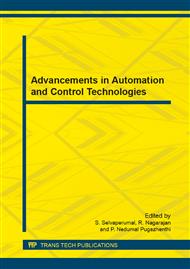[1]
Sanaa Taha and Xuemin (Sherman) Shen, A Physical-Layer Location Privacy-Preserving Scheme for Mobile Public Hotspots in NEMO-Based VANETs, IEEE Trans. On ITS May 26, (2013).
DOI: 10.1109/tits.2013.2265311
Google Scholar
[2]
R. El-Badry, M. Youssef, and A. Sultan, Hidden anchor: A lightweight approach for physical layer location privacy, Comput. Syst., Netw. Commun., vol. (2010).
DOI: 10.1155/2010/749298
Google Scholar
[3]
R. El-Badry, A. Sultan, and M. Youssef, Hyberloc: Providing physical layer location privacy in hybrid sensor networks, in Proc. IEEE ICC, Cape Town, South Africa, (2010).
DOI: 10.1109/icc.2010.5502104
Google Scholar
[4]
R. Baldessari, A. Festag, and J. Abeille, NEMO meets VANET: A deployability analysis of network mobility in vehicular communication, in Proc. 7th IEEE Int. Conf. ITST, Sophia Antipolis, France, (2007).
DOI: 10.1109/itst.2007.4295897
Google Scholar
[5]
R. Lu, X. Lin, H. Zhu, P. -H. Ho, and X. Shen, A novel anonymous mutual authentication protocol with provable link-layer location privacy, IEEE Trans. Veh. Technol., vol. 58, no. 3, p.1454–1466, Mar. (2009).
DOI: 10.1109/tvt.2008.925304
Google Scholar
[6]
T. Wang and Y. Yang, Location privacy protection from rss localization system using antenna pattern synthesis, in Proc. IEEE INFOCOM, Shanghai, China, Apr. 10–15, 2011, p.2408–2416.
DOI: 10.1109/infcom.2011.5935061
Google Scholar
[7]
S. Oh, T. Vu, M. Gruteser, and S. Banerjee, Phantom: Physical layer cooperation for location privacy protection, in Proc. IEEE INFOCOM, (2012).
DOI: 10.1109/infcom.2012.6195759
Google Scholar
[8]
U. S Department of Transportation, Vehicle safety communications project task 3 final report: Identify intelligent vehicle safety applications enabled by DSRC, , http: /www. its. dot. gov/research docs/pdf/59vehicle-safety. pdf, March (2005).
Google Scholar
[9]
L. Huang, K. Matsuura, H. Yamane, and K. Sezaki, Enhancing wireless location privacy using silent period, in Proc. IEEE Wireless Commun. Netw. Conf., 2005, vol. 2, p.1187–1192.
DOI: 10.1109/wcnc.2005.1424677
Google Scholar
[10]
S. Taha and X. Shen, Anonymous home binding update scheme for mobile IPv6 wireless networking, inProc. IEEE GLOBECOM, Houston, TX, USA, Dec. 5–9, (2011).
DOI: 10.1109/glocom.2011.6134034
Google Scholar
[11]
R. Baldessari, A. Festag, and J. Abeillé, NEMO meets VANET: A de-ployability analysis of network mobility in vehicular communication, in Proc. 7th IEEE Int. Conf. ITST, Sophia Antipolis, France, Jun. 6–8, (2007).
DOI: 10.1109/itst.2007.4295897
Google Scholar
[12]
R. Baldessari, W. Zhang, A. Festag, and L. Le, A MANET-centric solu-tion for the application of NEMO in VANET using geographic routing, inProc. 4th Int. Conf. Testbeds Res. Infrastruct. Dev. Netw. Communities, Innsbruck, Austria, Mar. 18–20, (2008).
DOI: 10.4108/weedev.2008.3146
Google Scholar
[13]
J. Choi, Y. Khaled, M. Tsukada, and T. Ernst, IPv6 support for VANET with geographical routing, inProc. 8th ITST, Phuket, Thailand, Oct. 2008, p.222–227.
DOI: 10.1109/itst.2008.4740261
Google Scholar
[14]
V. Sandonis, M. Calderon, I. Soto, and C. Bernardos, Design and performance evaluation of a PMIPv6 solution for geonetworking-based VANETs, Ad Hoc Netw., (2012).
DOI: 10.1016/j.adhoc.2012.02.008
Google Scholar
[15]
V. Devarapalli, R. Wakikawa, A. Petrescu, and P. Thubert, RFC 3963: Network Mobility (NEMO) Basic Support Protocol, 2005. [Online]. Available: http: /tools. ietf. org/pdf/rfc3963. pdf.
DOI: 10.17487/rfc3963
Google Scholar
[16]
C. Perkins, RFC 3344: Ip mobility support for IPv4, Network Working Group, 2002. [Online]. Available: http: /tools. ietf. org/html/rfc3344.
Google Scholar
[17]
Johnson, C. Perkins, and J. Arkko, RFC 3775: Mobility support in IPv6, IETF, Jun. 2004. http: /tools. ietf. org/html/rfc3775.
Google Scholar
[18]
S. Taha and X. Shen, Anonymous home binding update scheme for mobile IPv6 wireless networking, inProc. IEEE GLOBECOM, Houston, TX, USA, Dec. 5–9, (2011).
DOI: 10.1109/glocom.2011.6134034
Google Scholar
[19]
Y. Fan, B. Lin, Y. Jiang, and X. Shen, An efficient privacy-preserving scheme for wireless link layer security, in Proc. IEEE GLOBECOM, New Orleans, LA, USA, Nov. 30/Dec. 4, (2008).
DOI: 10.1109/glocom.2008.ecp.891
Google Scholar
[20]
R. Lu, X. Lin, H. Zhu, P. Ho, and X. Shen, ECPP: Efficient conditional privacy preservation protocol for secure vehicular communications, in Proc. 27th IEEE INFOCOM, Phoenix, AZ, USA, Apr. 13-18, (2008).
DOI: 10.1109/infocom.2008.179
Google Scholar


